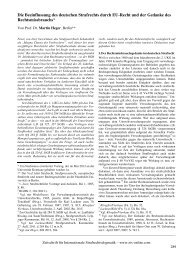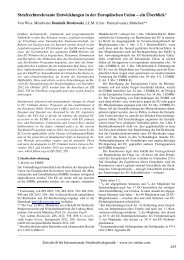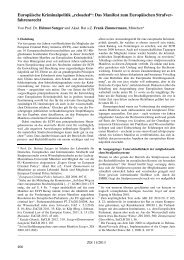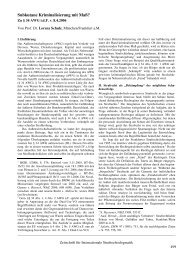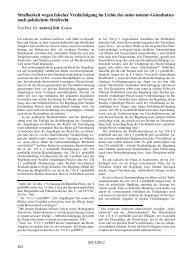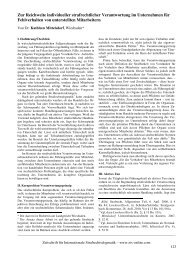Inhalt AUFSÄTZE ANHANG - ZIS
Inhalt AUFSÄTZE ANHANG - ZIS
Inhalt AUFSÄTZE ANHANG - ZIS
- No tags were found...
Create successful ePaper yourself
Turn your PDF publications into a flip-book with our unique Google optimized e-Paper software.
On Functional Perpetration in Dutch Criminal Law_____________________________________________________________________________________One of the most important questions – and obviously a crucialone for the purposes of this essay – is whether the conceptof functional perpetration could find application outsidethe scope of economic crime. Could someone incur criminalresponsibility as a ‘functional perpetrator’ of ordinary crimes,such as ‘theft’, ‘extortion’ and ‘murder’? 16 The Dutch SupremeCourt answered the question in the affirmative in aninteresting case on abortion. 17 The accused, a gynecologist,had been convicted for ‘having deprived a fetus of its life, byconducting the following acts: he had, as a gynecologist,examined the pregnant woman; he had hospitalized the womanand had assigned the assistant doctor to administer certainmedication, in order to prompt the premature and lifelessbirth of the fetus, which was intended and indeed occurred.’ 18The case sheds an interesting light on the nature of functionalperpetration. The first examples of functional perpetrationin the realm of economic crime suggest a rather passiveattitude. The ‘man in charge’ seems to connive, condone orfail to prevent offences, but does not actively pursue theircommission. The functional perpetrator considers economicoffences as ‘part of the game’, mirroring the dark side ofcommercial enterprise. Rather than actively countering themwhich would probably backfire on his profits, he chooses tocondone their occurrence and close his eyes. From this perspective,functional perpetration connotes ‘crimes of omission’and the mens rea concept of dolus eventualis. 19The case of the gynecologist demonstrates that such a pictureof functional perpetration is slightly misleading. In thepresent author’s view, the omission version of functionalperpetration rather indicates the utter limits of the concept.The characteristic feature of functional perpetration is that theaccused, by virtue of his function and his authority over others,is capable of prompting others to commit crimes. DeHullu points out that, in the case of the gynecologist, modesof participation, like perpetration by means of another person,incitement or co-perpetration, could easily have sustained theconviction of the accused. 20 Van Woensel highlights in particularthe close relationship between functional perpetrationand perpetration ‘by means of another person’. 21 The majordistinction between the two concepts is that Dutch criminallaw requires that, in case of perpetration by means of anotherperson, the immediate and physical perpetrator lacks criminal16 See Van Woensel (Fn. 8), p. 83-88 and de Hullu, Materieelstrafrecht; over algemene leerstukken van strafrechtelijkeaansprakelijkheid naar Nederlands recht (‘Substantive law;on general concepts of criminal responsibility in Dutch law’),Deventer, 4th ed. 2009, pp. 159-161.17 Supreme Court, 20 May 1990, NJ 1991, 217.18 Ibidem, translation by the author.19 In his interesting and well-informed contribution on thetopic, E. Gritter defends this too narrow approach of ‘functionalperpetration’ as an ‘Uneigentliches Unterlassungsdelikt’,Gritter, in: Van der Neut/Keulen (Ed.) Daderschap enDeelneming (‘Perpetration and Participation’), Deveneter,2007, pp. 22-24.20 De Hullu (Fn. 16), p. 160.21 Van Woensel (Fn. 8), pp. 107-139.responsibility, because of his age, he acts under excusableduress or is misguided (by error of law or of fact). From thisperspective, functional perpetration serves as an expansion ofcriminal responsibility, covering both the man behind thescreens and the guilty physical perpetrator. Wielding powerover subordinates suggests a hierarchical relationship withina structured organisation. 22 It depends on the specific aimsand objectives of the organization and the power of leaderswithin that organization to materialize those objectivesthrough other persons whether those leaders can be qualifiedas functional perpetrators. Those are exactly the features offunctional perpetration which make a rational comparisonwith Organisationsherrschaft useful and feasible.III. Functional Perpetration and Organisationsherrschaft:Distinctions and SimilaritiesThe previous section has made it abundantly clear that theconcepts of Organisationsherrschaft and functional perpetrationdo not fully correspond. Different from Organisationsherrschaft,functional perpetration is not predicated on arigid command structure; it rather presumes the potential tosteer – and correct – the conduct of subordinates. Furthermore,the organization in which or through which the functionalperpetrator acts, need not have strayed from the Righteouscourse; offences may just be incidents in a corporationwhich pursues lawful goals by lawful means, a corporationeven with an unblemished reputation. Thirdly, functionalperpetration does not require that the physical perpetratorserves as fungible tool in the hands of the man behind thescenes; the former may be a relatively autonomous agent. 23The only conditions are that the offences have been committedwithin the scope of the organization’s daily business andthat the employer or boss could have intervened to stop hissubordinate from persisting in the evil. A hotel owner, forinstance, cannot be held criminally responsible for the bellboy’sindecently assaulting the waitress. Finally, and this isto a certain extent the mirror image of the previous aspect,the physical perpetrator need not be a ‘willing executioner’himself; he may simply be ignorant of the fact that he actsunlawfully, or lack the quality which is required for thecommission of the crime. 24 In this sense, functional perpetra-22 Compare also De Hullu (Fn. 16), p. 159 who does notconsider the nature of the crime to be decisive, but rather thefactual context of whether an organisation with a certainhierarchical structure was involved in the crime.23 Ambos has criticized the element of ‘fungibility’ in view ofincreasing specialization within modern bureaucracies. Hecorrectly points out that an accused need only to demonstratethat his skills are indispensable, in order to escape responsibilityunder the heading of Organisationsherrschaft. Ambos,in: Nollkaemper/van der Wilt, System Criminality in InternationalLaw, 2009, pp. 145 (146).24 In the classical ‘Milk and Water’-case (Supreme Court, 14February 1916, NJ 1916, 681) the accused stood trial forhaving delivered – through another person – adulterated milk.The physical perpetrator, the accused’ servant, did not knowthat he delivered adulterated milk, nor was he allowed to_____________________________________________________________________________________Zeitschrift für Internationale Strafrechtsdogmatik – www.zis-online.com617




